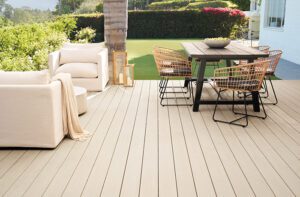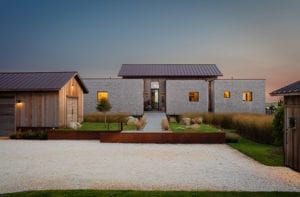Interior Design: TV versus Reality
August 10, 2018
SPONSORED CONTENT
Text by Kaitlin Madden
An interior design veteran sheds light on common myths proliferated by the decor media.
Thanks to the explosion of design-centric television shows, blogs, and social media stars in recent years, interiors are getting more attention than ever before. And while that’s certainly good news for designers feeling a boost from people seeking spaces that rival those in their Instagram feeds, there’s also an increasing disparity between the reality of working with an interior designer and the perception created by the “as seen on TV” version of the experience.
Lisa Davenport, owner of Lisa Davenport Designs in Durham, Connecticut, has experienced the dichotomy firsthand. “Kudos should definitely go out to mainstream media, Instagram, and bloggers for bringing awareness to our industry. They’ve made interior design a topic that’s no longer just reserved for royalty,” Davenport says. “But unfortunately in the name of entertainment, what you see isn’t always reality and it can create unrealistic expectations for consumers. For example, there are shows where, within four weeks and with little monetary output, [the team] guts the first floor of a house and puts in a new kitchen with custom cabinetry and a new living room and everybody is happy in the end.
To set the record straight, we asked Davenport about the biggest differences between what’s shown on television and the reality of working with an interior designer. Here’s what she wants you to know.
TV “budgets” aren’t always transparent.
First and foremost, Davenport points out a fallacy that shouldn’t be all that surprising: not everything on TV is what it appears. Especially, she says, when it comes to the budget.
“On a TV series, the labor and the products are often grossly discounted or donated in exchange for vendors being part of the show,” the designer explains. “Imagine the sticker shock when someone calls a designer and says ‘I’d like to do my kitchen over,’ and they have a $20,000 budget, and they want professional appliances, quartz countertops, custom cabinetry, and glass tile. But the high-end appliances alone will cost $20,000.”
“Unfortunately, I’m the one who has to burst that bubble,” says Davenport.
Design is a process…and it can be a long one.
While television crews have been known to turn over design transformations in a weekend, Davenport says in reality, even the simplest of projects often take much (much) longer.
“Exact timelines obviously depend on the project, but even if we’re just decorating a space without any major renovations, it takes time for products to arrive,” Davenport says. “A sofa in custom upholstery takes four-to-eight weeks. In a kitchen, true custom cabinets can take twelve to eighteen weeks, and countertops are at least two weeks out.”
And when it comes to large-scale renovations? Timelines are based on a delicate dance among the pros doing the work. In other words: the high-stress installation scenes that add watch-worthy drama to a television show would spell disaster in real life. “In a real-life renovation, you would never have the painter working on top of the electrician, and one person grouting the tile in one half of the room while someone else is still laying it in the other,” she says. “Products need time to cure and do their job properly.”
DIY doesn’t mean done for less.
DIY is a major component in many of the most popular home design TV shows and blogs, and while there are certainly people who do DIY well, says Davenport, it can create major headaches (and blown budgets) for those without much experience in proportion, space planning, or selecting materials.
“Part of what designers study in school is how people interact with their space,” Davenport says. “I worked in a house that was previously flipped by an experienced contractor who thought he could do it without a designer, and when it was done the oven door in the kitchen barely cleared the island when you opened it.” And that’s just one example.
In fact, one of the of the biggest benefits of working with an interior designer is proper planning and execution: you’re teaming up with someone who can spot problems you’d never anticipate, or recommend solutions you’d never dream up. “Take linen drapery panels, for example,” says Davenport. “They look beautiful when you first put them up on the window, but if you’re living on the Connecticut shoreline, and you’re going to keep your doors open on the beautiful summer nights, you’ll probably have humidity in the air, and those draperies are going to grow. They’ll suddenly be two or three inches longer, dragging on the floor.”
It’s worth it to discover your own style.
There’s no shortage of inspiration to be had when it comes to decorating a beautiful space, but that doesn’t mean a photo you love from a magazine or a room you saw on TV represents the style you should live in. Davenport sees it as her job to help her clients interpret trends and inspiration for their unique style and lifestyle.
“People are inundated with trends now. Take white cabinetry for example–when a client comes to me and says they want white cabinets, I say let’s explore that, but let’s explore some other ideas too,” she explains. “We have a project in Connecticut where we are installing warm white cabinets, but the built-ins in the dining space, which you can see from the kitchen, are apple green, and the pantry is a beautiful slate blue, and the mudroom is a taupe-meets-gray color, so there is plenty to play up the white.”
The end result may not be something straight out of an HGTV show, but instead, something even better: an interpretation of a trend or style that is uniquely personalized to the people who live in the home. “That’s what a designer really brings to the table,” Davenport says.
Lisa Davenport Designs
Durham, Connecticut
860-316-5718
Naples, Florida
239-260-1845
lisadavenportdesigns.com
Share
![NEH-Logo_Black[1] NEH-Logo_Black[1]](https://www.nehomemag.com/wp-content/uploads/2022/08/NEH-Logo_Black1-300x162.jpg)















You must be logged in to post a comment.